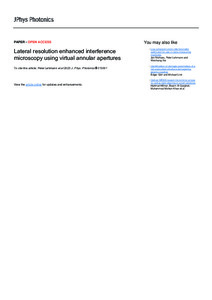| dc.date.accessioned | 2023-05-19T10:38:17Z | |
| dc.date.available | 2023-05-19T10:38:17Z | |
| dc.date.issued | 2023-01-27 | |
| dc.identifier | doi:10.17170/kobra-202305198061 | |
| dc.identifier.uri | http://hdl.handle.net/123456789/14727 | |
| dc.description.sponsorship | Gefördert im Rahmen des Projekts DEAL | |
| dc.language.iso | eng | |
| dc.rights | Namensnennung 4.0 International | * |
| dc.rights.uri | http://creativecommons.org/licenses/by/4.0/ | * |
| dc.subject | interference microscopy | eng |
| dc.subject | coherence scanning interferometry | eng |
| dc.subject | three-dimensional transfer function | eng |
| dc.subject | lateral resolution | eng |
| dc.subject | Fourier optics | eng |
| dc.subject | Kirchhoff approximation | eng |
| dc.subject.ddc | 530 | |
| dc.title | Lateral resolution enhanced interference microscopy using virtual annular apertures | eng |
| dc.type | Aufsatz | |
| dcterms.abstract | The lateral resolution in microscopic imaging generally depends on both, the wavelength of light and the numerical aperture of the microscope objective lens. To quantify the lateral resolution Ernst Abbe considered an optical grating illuminated by plane waves. In contrast, the Rayleigh criterion holds for two point sources or point scatterers separated by a lateral distance, which are
supposed to emit spherical waves. A portion of each spherical wave is collected by the objective lens and results in an Airy disc corresponding to a diffraction limited intensity point spread function (PSF). If incoherent illumination is employed the intensity PSFs related to different scatterers on an object are added resulting in the well-known Rayleigh resolution criterion. In interference
microscopy instead of the intensity the electric field scattered or diffracted by an object will be affected by the transfer function of the optical imaging system. For a reflective object the lateral resolution of an interference microscope can be again characterized by the Abbe limit if the object under investigation is a grating. However, if two irregularities on a flat surface are being imaged the
resolution no longer obeys the Rayleigh criterion. Instead, it corresponds to an optical system with an annular aperture and thus surpasses the prediction given by the Rayleigh criterion. This holds true for both, amplitude as well as phase objects, as it will be elucidated in this study by theoretical considerations, simulation results and an experimental proof of principle. | eng |
| dcterms.accessRights | open access | |
| dcterms.creator | Lehmann, Peter | |
| dcterms.creator | Hüser, Lucie | |
| dcterms.creator | Stelter, Andre | |
| dcterms.creator | Kusserow, Thomas | |
| dcterms.extent | 14 Seiten | |
| dc.relation.doi | doi:10.1088/2515-7647/acb249 | |
| dc.subject.swd | Interferenzmikroskopie | ger |
| dc.subject.swd | Übertragungsfunktion | ger |
| dc.subject.swd | Fourier-Optik | ger |
| dc.type.version | publishedVersion | |
| dcterms.source.identifier | eissn:2515-7647 | |
| dcterms.source.issue | Number 1 | |
| dcterms.source.journal | JPhys Photonics | eng |
| dcterms.source.volume | Volume 5 | |
| kup.iskup | false | |
| dcterms.source.articlenumber | 015001 | |


